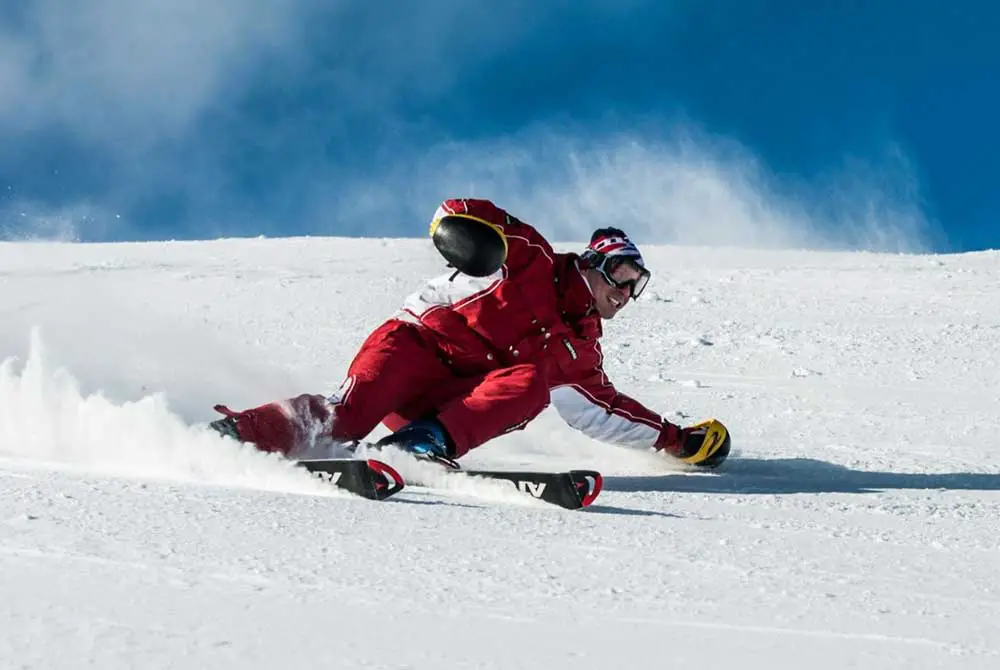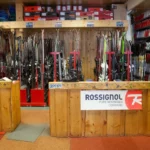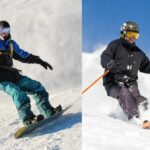You may think that stopping on skis is easy, after all, you may have watched people do it or have learned to hockey stop while ice skating or rollerblading, so it’s surely the same thing, right?
Unfortunately, stopping on skis isn’t quite so easy to learn as it may seem, and it’s easy to pick up bad habits that slow down your progress and make it harder for you to stop than starting from scratch and learning to stop properly.

Stopping is usually the first thing you want to learn if you’re interested in skiing. Not knowing how to stop effectively is dangerous both for you and for other skiers out on the slopes, and while it can be embarrassing to fall over, not being able to stop effectively can also lead to serious injury for you and anyone nearby.
The last thing you want to do is ruin your trip right at the start, or spoil anyone else. To prevent this we’ve compiled a list of the three best techniques for stopping effectively.
The first and most easy method of stopping is the snowplow stop, which is sometimes referred to as the pizza stop. Next, we have the wedged turn stop which is a little more difficult than the snowplow, and finally the very cool but difficult to master hockey stop.
Each of these stops is useful in a variety of scenarios, and there’s no shame in relying on the basic stops even if you’re an experienced skier. Safety is the most important thing, style can come later!
Now let’s break down each stop and how to do them.
The Snowplough Stop
The simplest and safest stop is the snowplow, aka, the Pizza Stop. This technique is the first one any instructor will show you, and it’s one of the most versatile and rudimentary options in every skier’s kit.
The snowplow stop is great for first-time skiers as it’s easy to learn and very effective, allowing skiers to control their speed easily on relatively simple slopes and gain confidence and control.
The snowplow stop works by forming a wedge with your skis, by pushing out your ankles. This wedge creates a large surface area and friction which pushes on the snow and slows down your speed considerably and in a controlled manner.
This stop is known as the pizza because when in the correct orientation, the skis resemble a slice of pizza during this technique.
Skiers at every level will use this stop at one time or another, and it's always there to provide stability in moments of panic or uncertainty.
How to perform this stop;
The best place to practice this technique for beginners is the green slope, where there is plenty of space to move and a gentle gradient which makes controlling speed easier.
Usually, you will be shown how to perform this stop while at a standstill, before being encouraged to try it at increasing speed to build confidence.
- Push the back of your skis outwards to make a wedge or pizza slice. This will immediately give you a sense of resistance and slow you down as the snow starts to push against your skis.
- Continue pushing the skis out until you reach an angle that provides you with enough stopping power to slow into a complete stop.
- To add stopping power, you can push down into the ground with the inside edges of your skis to increase the friction and reduce the stopping distance, however, be careful not to overdo it or you may totally lose control, particularly at speed.
This is a stop that can be practiced while being pulled along by a friend on a flat surface before you move up to try it on a small slope.
This stop is best used on gentler slopes or when your speed is already under control and slowing down. If you feel yourself starting to lose control on a slope, enter the snowplow immediately to regain control more easily, by increasing your stability and reducing your speed.
Top Tips
- Don’t ever use your ski poles to slow down or stop, this is dangerous and will throw you off balance. Ski poles are primarily for gaining speed alone and maintaining some stability. They are not intended to function as brakes and will likely be damaged if you try to stop with them.
- Keep your center of gravity back and lowered as you snowplow to increase stability.
- Don’t be afraid to start slow and build confidence gradually
Wedged Turn Stop
The wedged turn stop is another method of braking that is quite similar to the snowplow but incorporates turning to improve the stopping distance and help avoid objects and navigate down a run without totally stopping.
This is a fundamental skill and the next step in managing your speed after mastering the snowplow stop.
The steps to making a wedged turn stop are essentially the same as the snowplow, but you put a bit more weight onto one of your legs/skis which will naturally turn you in your desired direction.
This decreases speed additionally by reducing the gradient and angle of attack you are skiing. Cutting across a slope makes it much easier to ski down as opposed to heading straight down it without turning at all.
How to perform this stop;
- Enter the snowplow as you would from the first example above
- Push more weight onto one ski and allow it to turn you. You can turn the ski to the side more to assist with this and even turn the ski out a little further than the opposite side too if you’re confident.
- If you need to turn left, you push more on your right ski. If you need to turn right, you push more on your left ski.
- As you turn your aim is to point your skis towards the side of the run/mountain. You can alternate from each ski to quite easily manage your speed and make your way down runs safely and effectively by turning the opposite way as you get to each side of the piste.
- If you intend to come to a full stop, keep the weight on the dominant side you turned with and use the inside edges of your skis to prevent yourself sliding down the slope once you’ve stopped.
Top Tips
- It’s natural to find it easier turning on your more coordinated side. Don’t neglect the side you find more difficult on.
- Keep your upper body relaxed and central as with the snowplow stop.
- Again, build up your confidence gradually!
Hockey/Parallel Stop
The stop which is the hardest, most efficient, and objectively the coolest looking is the hockey stop or parallel stop.
This is the stop favored by experienced skiers who know how to parallel turn, a more advanced form of turning and control which signifies a skier has become a confident intermediate skier.
The parallel stop is the fastest and best way to avoid collisions or unexpected obstacles and will stop you much more aggressively than other stops.
How to perform this stop
- Prepare to unweight yourself by standing up just before you start this stop, reducing your contact with the snow.
- Begin a parallel turn, setting your weight on the outside or downhill ski as you turn. The more weight you place over this ski the faster you will stop but the harder it will be to stay in control.
- Turn your skis parallel and bend your knees, digging into the snow with both inside edges of your skis and pushing out through your heels.
- Don’t overlean to compensate, try to stay balanced and counteract the momentum but keep your upper body as relaxed as possible.
- Reduce the angle of your skis as you slow down to prevent falling and enter a normal stance as you come to a stop.
The hockey stop is elaborate and difficult, especially if you can’t parallel turn confidently, so don’t be hard on yourself and make sure you get the fundamentals right to avoid picking up bad habits and reducing the long-term quality of your skiing technique.
The Importance of Stopping

Not knowing how to stop makes you a liability, a runaway train heading out of control and unlike to stop until you hit something, someone, or simply fall over and enter a dangerous out of control roll.
Learning to stop is like walking before you can run, and is the most essential technique to staying safe on the mountain.
Bonus Stop - The Full Turn Stop
There is one other emergency method of stopping that you can use if you’re in a panic on the slope and don’t know what to do.
This stop is sometimes referred to as the full turn stop or riding out the turn.
Essentially you use the terrain against itself and is a great tool for times when you may be going too fast to simply enter a snowplow stop.
To do this, place your weight more over one ski as with the wedged turn, but crucially instead of linking the wedged turn into another turn in the opposite direction, allow yourself to continue turning in the original direction until you begin to turn around and your skis start to face uphill.
This will slow you down very quickly as the gradient of the hill works against you, however, be mindful of what’s around you as skiers behind you may be taken by surprise. Make sure to stay out of the center of the piste!
- Types of Skiing Terrains: A Comprehensive Guide for Every Skier - December 6, 2024
- Skiing Nutrition: Essential Nutritional Advice and Meal Planning for Skiers - August 15, 2024
- Backcountry Skiing Explained: Essential Tips and Gear - August 8, 2024








